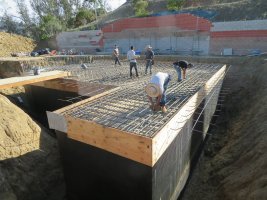jeffc
Bronze Member
If they installed a vacuum relief valve, I'd call this install good
The topping slab is 7" thick.
Thanks for the reply, ICE. We see it now! FYI: We don't approve TPR drain piping that has a reverse slope. The pipe must be sized properly, secured and have minimum slope to an approved drainage location.
Would that be a garage slab?
ICE
Picture 3750 shows a potable water tank/heater with an expansion tank. I see expansion tanks on hot water boilers but not water heaters. Is this a California requirement?

keep us informed on how the pour goes!It is a slab over a basement. About 1000 sq. ft. 12" thick. No support except the perimeter. The form is 1/2" plywood with posts and beams holding it up. I asked the young man that's in charge where the design of the shoring came from....turns out that it was the crew that's tying steel. 140,000 lbs. of wet concrete will be held up by the best guess of the crew.
I asked for an engineered plan to be submitted for review. Then a structural observation by the engineer. I wouldn't bet on 1/2" plywood making it through the process....but who knows.
View attachment 6218
Did they just come off a project in new orleans?where the design of the shoring came from....turns out that it was the crew that's tying steel.]
I have not seen any tape with markings on the tape itself. Did you see a spool?...at least it lacks any markings....
The spool is embossed “PIPE TAPE” and nothing more.I have not seen any tape with markings on the tape itself. Did you see a spool?
Wrong teflon tape. This tape is not listed for any use....at least it lacks any markings.... It's an awful mistake on 135' of 2" pipe. There is some pipe dope visible here and there along with the tape used in the same coupling.
View attachment 6217
http://www.comfortradiant.net/TuffCableRoof.phpwhy I hate my metal roof - Oh and I wanted to show the contrast from the picture ICE put on saying it was "winter". I did not take a picture of it by my service drop actually has about 2" of snow on it - all of our power lines are sagging under this storm.View attachment 6223
look at UPC 608.5 (5) and your picture is an incorrect installationI've not given it any thought before but rotating the valve is probably not a great idea.
look at UPC 608.5 (5) and your picture is an incorrect installation
Wrong teflon tape. This tape is not listed for any use....at least it lacks any markings.... It's an awful mistake on 135' of 2" pipe. There is some pipe dope visible here and there along with the tape used in the same coupling.
View attachment 6217
